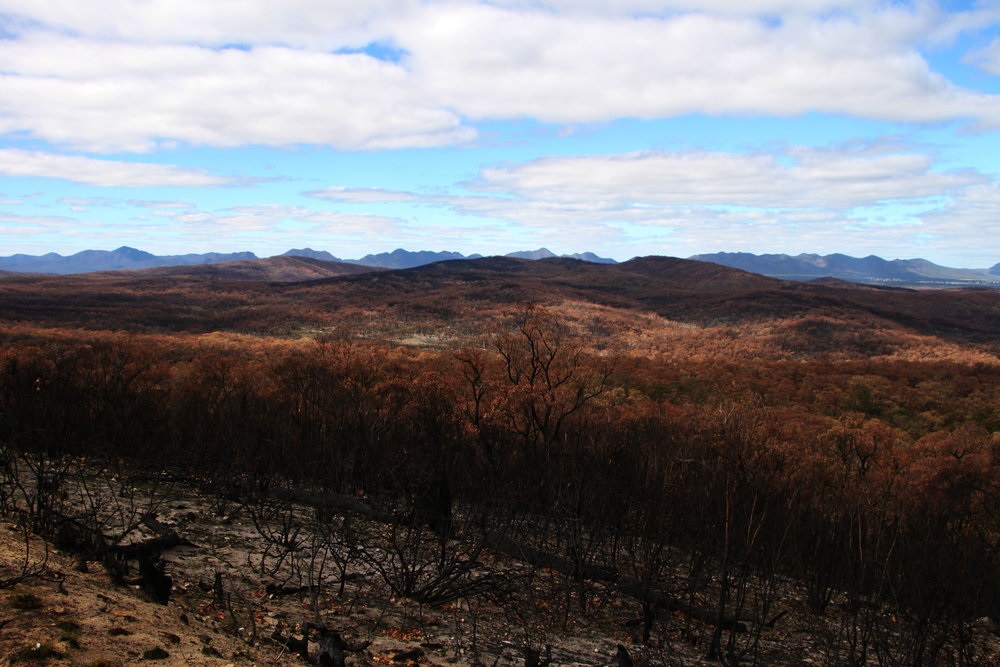This is a guest post by Deakin University PhD student Susannah Hale and Associate Professor John White.
From burning to booming (and back again) – a tale of fire and water.
Back in 2006, a major wildfire burned approximately 85,000 hectares of the Grampians National Park. Lightning sparked the blaze and a burning question – how will the system respond to this large, high intensity fire? Although we didn’t know it at the time, this event was the forerunner to the birth of a long term study and partnership. Every year for the past nine years, a Deakin Wildlife and Conservation Biology Honours student has taken on the task of delivering the Grampians mammal trapping. Without fail, these students have (with some trepidation) dived into the experience before emerging triumphant and as confident and competent researchers.

We annually trap 36 study sites throughout the park. When the trapping first began, we were inundated by exotic species (mostly the invasive house mouse). The region was recently burnt but was also in the grips of the ‘Millennium Drought’ – not an ideal situation. After a few more years of poor rain, the landscape was drenched for the first time in many years and with that, the drought was broken (but sadly not for long!). With the downpour came an uprising.
In 2012, 18 months after the deluge, the mammal numbers had boomed, doubling from the previous year and almost four times the numbers of the first year. The sheer amount of mammals was not the only change; the composition had shifted to a landscape dominated by native species. This was an exciting time with the smoky mouse being detected for the first time in the study, as well as an albino heath mouse and many bandicoots carrying pouch young captured.

While these conditions seemed to be conducive to small mammals, it presented a number of challenges for our research team. Many roads crumbled during the onslaught of rain, making access incredibly difficult and time consuming. After many kilometres at a snail’s pace, help from the Parks Victoria quad bike, and a series of turnarounds, trapping was completed.

Following on from this boom the rainfall once again began to decline. As a result, the mammal numbers followed suit before stabilising at low numbers from 2014 onwards. Native species are still managing to dominate the landscape, although in the last two years the number of house mice has begun to increase – funnily enough there were 127 captures in both 2015 and 2016, what are the chances!? As these conditions have unfolded, we have seen an incredible opportunity to investigate the impacts of future climate change. Future scenarios outline an era where there is a highly variable climate, with protracted periods of below average rainfall punctuated by flooding events. It was like looking in a mirror!

Since we began our investigation into the effects of variable climate, our research has yielded some unexpected results. What we have found indicates that our temperate system is acting much like the arid regions of Australia. In arid zones, mammals experience booms and busts associated with the sporadic rainfall that these areas receive. What we’ve found is that our system (originally thought to be more predictable and stable in that sense) was responding this way as well.
With native species showing a preference for areas that remain unburnt for longer, the pattern of wildfire occurrence becomes increasingly worrying; with larger and more regular fires looking to become the norm, the future of our native species may be threatened. In the last 10 years alone, approximately 90% of the Grampians National Park has experienced wildfire (in 2006, 2013 and 2014!), leaving very few long unburnt areas. This means that the distribution of fire age classes is less than optimal for small mammals.
The interaction between the effects of fire and climate create a complex web to manage for biodiversity; it does, however, provide hope. We have seen populations bounce back from almost undetectable levels, so as long as conditions don’t remain sub-optimal for extended periods and large, high intensity wildfires do not increase in number, experienced species should have the capacity to recover.
Our experience in the Grampians has been amazing, and thought-provoking. We have realised the significance of and invaluable knowledge obtained from long term studies, especially when facing the uncertainty of the effects of future climate change. It allows us to observe the peaks and troughs experienced by a system that may have been overlooked or undetectable in a snap shot study. While snap shot studies are important, we need to value and support long term studies, particularly as the onset of climate change intensifies.

Check out our latest paper from our Grampians research here.
Follow our research on Twitter @Wild_Gramps
All images were taken by Susannah Hale.


Leave a Reply